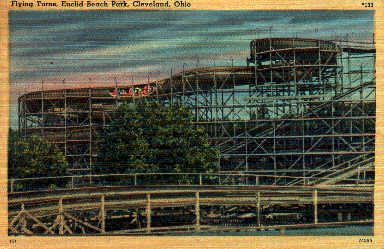Photograph Gallary from Holiday in the Park Shows 2019
Click on an image to flip through larger images.
[ngg src=”galleries” ids=”1″ display=”pro_tile”]The Unofficial History of Six Flags Over Texas
Photograph Gallary from Holiday in the Park Shows 2019
Click on an image to flip through larger images.
[ngg src=”galleries” ids=”1″ display=”pro_tile”]Aquaman: Power Wave is set to open at Six Flags Over Texas for the 2020 season. The ride replaces “AquamanL Splashdown”. Both rides are themed based on the D.C. Comics superhero “Aquaman”.
The ride is being promoted as a “first of its kind” “next generation” water coaster.
The ride vehicles is a 20 passenger boat, similar to the previous Aquaman ride. Rather than riding in a circular track, as with the original Aquaman, the boats will be propelled up 148 feet twin track towers located at each end of the water way. After rising up the towers, the boats will plunge straight down. The boats will travel along 700 feet of track and travel at up to 63 miles per hour. As with the original, the ride ends with a large splash propelled around and onto the boats and the nearby spectators.
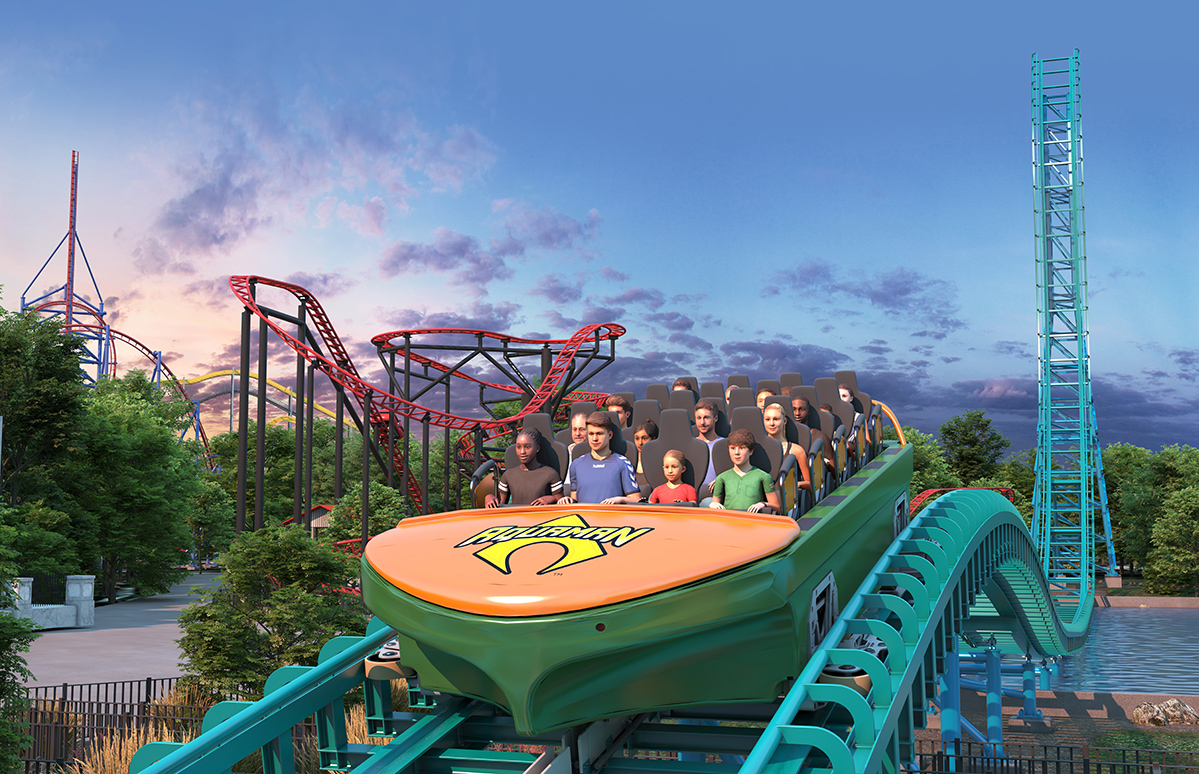
The propulsion of the boats is generated with magnets.
It is the first coaster of its time in North American and is being constructed at this time.
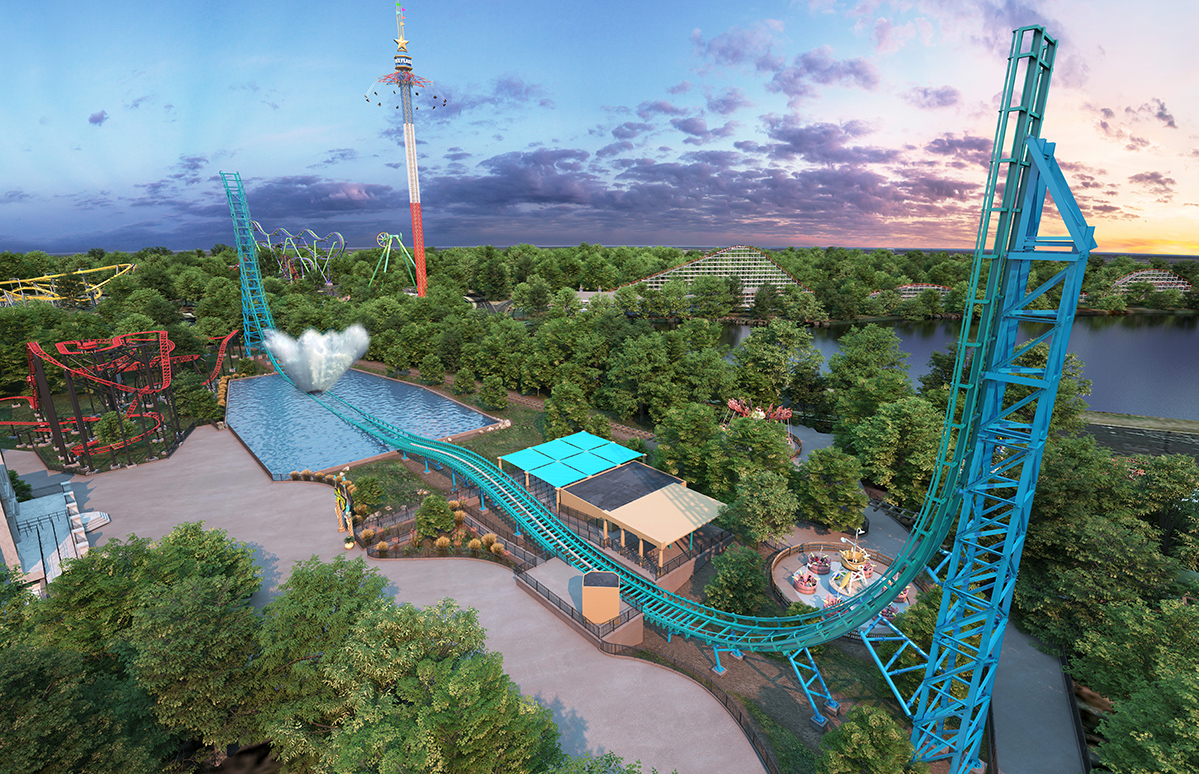
The Ten Oldest Rides still operating in the park are as listed. Each is profiled with an article at this site. The list also corresponds with all of the rides built in the 60s which are still operational in the park.
1. The Six Flags Railroad – Opened 1961;
2. Chaparral Cars – Opened 1962;
3. The Flume Ride – opened 1963;
4. The Silver Star Carousel – opened 1963 (closed 1986 & 1987 for remodeling);
5. The Cave Ride – open 1964; rethemed 1992;
6. El Sombrero – opened 1965;
7. Runaway Mine Train – opened 1966;
8. Tower – open 1969; closed for renovations 1998
Mini-Mine Train – open 1969; closed for renovations & reconstruction 1997.
10) the Rugged Buggy, now a Loony Tunes land ride was added in 1972, in the petting zoo.The Rugged Buggy is the park’s oldest “kiddie ride”.
The next major ride to be added, which is still in the park, is the Texas Chute-out, added in 1976. The Red Baron, also now a Loony Tunes land ride, was also added in 1975.
The next major ride to still be operating in the park is the Shockwave, which opened in 1978.
NOTES:
The Flume is considered older than the Carrousel, as the Carousel was closed for two full seasons.
The Tower and Mini-mine Train are considered tied for 9th oldest, as both have been closed for a season.
(c) Davis McCown
Last Update: August 17, 2010
Harley Quinn Spinsanity was installed in 2018. Although the park had previously hosted a ride with the same name, that ride was unrelated to the newer ride using the same name.


The Story of Sis, The Six Flags Elephant
When Six Flags first opened in 1961, one of the attractions was a petting zoo. The zoo was located in the USA section in the area where Looney Tunes Land is now located.

One of the most notable attractions at the zoo was Sis the Six Flags Elephant (Sissy). In fact, there were several “Sis” Elephants. Due to the rate at which the young elephants grow, each “baby” elephant was replaced after one or two seasons. This article concerns Sis VI, the sixth Elephant to live in the Six Flags Petting Zoo. Sis has had a most exciting, although not always happy, live.
The elephants in the pictures to the right are actually earlier Sis elephants. One is SIS II. Sis I was in the park from 1961 through 1963. The first SIS is shown in two of the shots to the right.
BACKGROUND
Sis is an Asian Elephant, from Bangkok, Thailand. She came to Six Flags in April of 1969. At that time, she was five months old, 34 inches high and weighed 160 pounds. Her exact birthday is unknown, so it has been sat at December 1, 1968.
Sis apparently was removed from her Elephant family too soon, and as a result, did not properly develop socialization skills necessary to interact with other elephants.
SIX FLAGS
Sis was officially named “Sis Flagg” by the park, as a play on the name Six Flags. She was a regular feature in the petting zoo as shown by the shots on the right of earlier Sis elephants.
The Story of Sis

I Believe that this is Young Sis II
This is the Elephant in the Article
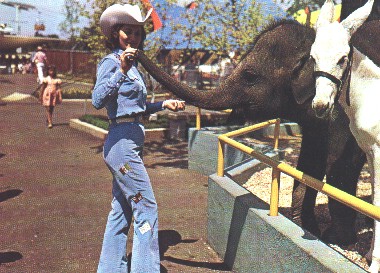
Sis I at the Petting Zoo, early 60s.
This is the First SIS and not the SIS in the Article.

Sis I at the Petting Zoo, early 60s.
This is also the First SIS and not the SIS in the Article.
Larry Thomas is on the right.
Her life in the park was essentially uneventful. Other than the occasional complaint that she stepped on someone’s foot, or push someone into the rail, she got along well.
Eventually, however, she became too large to keep as a petting Zoo animal. She left the Six Flags amusement park in November of 1969.
There were more Sis Elephants after Sis VI. In particular, there was one that died in the park in about 1975. That may have been the last elephant Six Flag’s had, as the park stopped keeping elephants in the mid 1970’s. The Petting Zoo was closed after the 1982 season and converted into the Children’s ride area. It is now Looney Tunes land.
In any case, Sis was sold to the Frank Buck Zoo in Gainesville, Texas in November of 1969. The school children of Gainesville collected pennies to buy the elephant. The children raised $3,900.00. The park sold the elephant for her purchase price of $3,400.00, so the Zoo had $400 left over for the care of Sis.
She was very popular at the Zoo. She was called Gerry II at Gainesville, because she replaced an elephant that died and was known as Gerry. She was a favorite attraction at the Zoo.
THE FLOOD of 1981
The Zoo was, however, built in a flood plain. In 1981, it flooded and Sis was literally submerged. She had to stick her trunk up in the air and wrap it around a tree limb just to breath. She was trapped in the flood waters for over a day.
Such suffered trauma as a result of the storm and still has problems dealing with storms and being washed.
THE FORT WORTH ZOO 1986-1988
In 1986 she was sent to the Fort Worth Zoo at the age of 24. This was the first time that she had been with other elephants. She did not adjust well to the unfamiliar surroundings and was not equipped to deal with the other elephants. After a very unhappy two years, she returned to Gainsville.
THE GAINSVILLE INCIDENT MAY 1997
She went back to Gainsville, which was essentially her life long home. But after she returned to Gainsville, a Zoo Keeper was killed in Sis’s enclosure. Although it is not know what happened, Sis became known as a killer and Gainsville wanted to be rid of her.
THE HOUSTON ZOO APRIL 1998
In April of 1998, Sis went to the Houston Zoo where she could again be with other Elephants at a top rate facility. She still could not socialize well with other and was suffering depression from her various traumas.
THE EL PASO ZOO NOVEMBER 1998
The Houston Zoo was just a temporary stopping point while arrangements were made for her new home at the El Paso Zoo. She was sent to the El Paso Zoo before her new home was completely made ready.
MISTREATMENT
Her arrival at the El Paso was videotaped. She was treated so badly by Zoo Keepers when she arrived that the City Council voted to remove her from the Zoo.
Those that have viewed the videotape described it as a “savage beating.” She was struck on her legs with bats and ax handles. The beating lasted several hours.
She was not received well by the other elephants either, and one knocked her over at least twice. A crane had to be used to stand her back up.
As a result of her beating, the US Department of Agriculture charged the Zoo with violations of the Federal Animal Welfare Act. In addition, the Zoo Director resigned.
While at El Paso, she suffered a partially paralyzed trunk as well.
THE ELEPHANT SANCTUARY 2000
As of January 26th, 2000, Sis is at The Elephant Sanctuary in Hohenwald, Tennessee. Upon her arrival, she was in poor health, did not eat or sleep well and suffers emotional trauma. She is now, however, doing very well, although she may have to undergo tooth surgery. She is even learning to get along with the other elephants.
The Elephant Sanctuary bills itself as the “first natural habitat refuge developed specifically for endangered Asian elephants.” It operates on 800 acres near Nashville.
Hopefully, she can spend the rest of her days at the Sanctuary in peace. Normally, her lifespan in the wild would be nearly 70s years. She is now forty-two.
Read more about Sis at Sissy’s Page at the Elephant Sanctuary.
Donations for her support can be made at: Sissy’s Support page.
last update: March 8, 2008
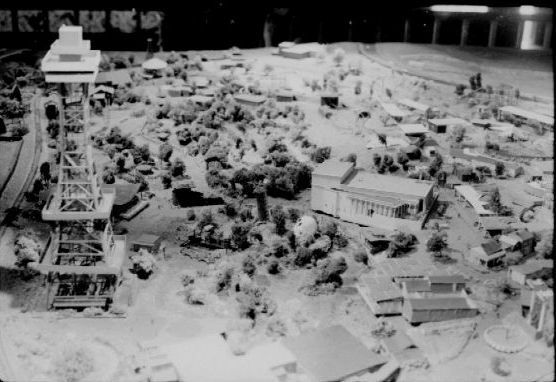
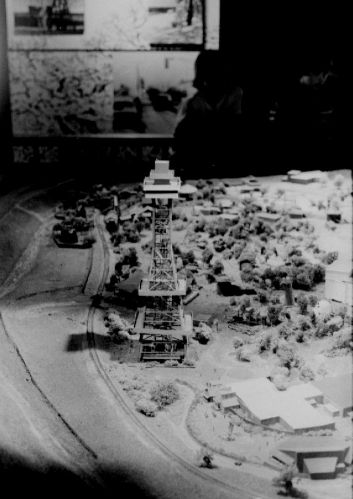
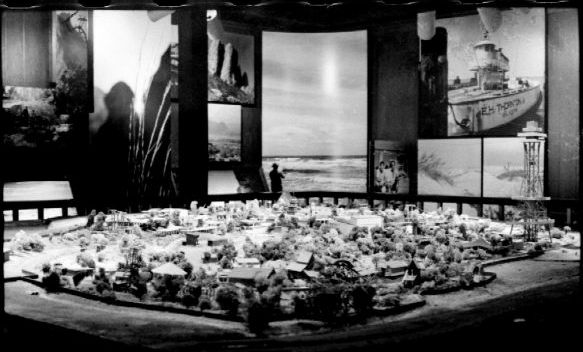

Both the Flume ride and the Rolling Rapids have established that crowds in the Texas heat will appreciate a ride that gets them wet. Splashdown Falls, built in 1986 and opening in 1987, was built as the simplest ride that could accomplish this task. The ride is now named the “Aquaman”, based on one of the DC Comic Characters.

The design consists of a large lift hill, which pulls the rides’ six boats over fifty feet in the air. The boats then travel through a 180 degree curve section, where they then fall down a 45 foot drop at a 35 degree angle into a splash pool below. The twenty foot boats are each designed to hold 20 riders sitting in five rows of bench seats, for an hourly capacity of 1,800.

Up to twenty riders sitting in the boats five bench style rows, all experience some degree of splash. In addition, the riders could wait on the exit bridge after disembarking for the next boat to fall. Doing so, they could experience the full impact of the boats splash, virtually guaranteeing that they will be soak through and through.
The 800-foot ride uses 250,000 gallons of water, circulated around the ride by a 180 Horsepower pumping station.The ride was built by O.D. Hopkins Associates. Inc of New Hampshire.
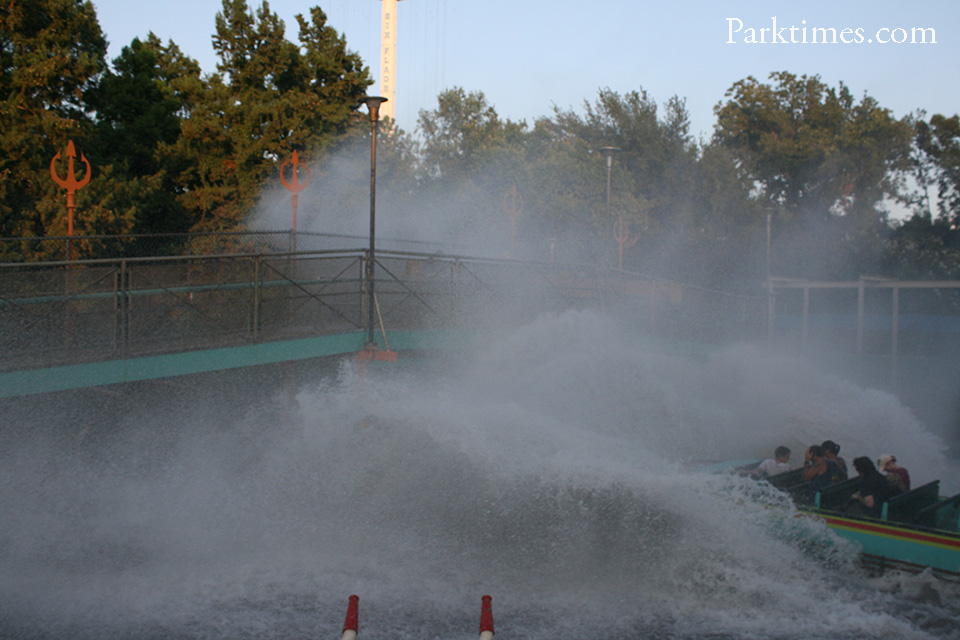
The ride’s name was inconsistent over the years. It was known as Splashwater Falls, just “Splashwater”, and Splashdown Falls in various publications The ride was later renamed the “Splashdown Reentry Test Simulation” to correspond with the retheming of the modern section to an Astronaut training center with the addition of the “Right Stuff” simulator. The final name was “Aquaman Splashdown“.
The ride was closed during the 2019 season to begin work on Aquaman: Power Wave to open in 2020.

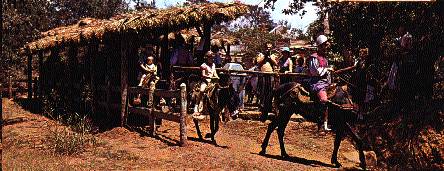
The Burro ride was a live animal ride which operated for the park’s first two seasons at what is now the site of the Log Flume Ride. For its short existence, the ride was basically the only attraction for the park’s Spanish section.
The premises of the ride was that the guest were following in the shadow of Spanish conquistador Francisco Vasquez de Coronado. The journey consisted of a mule-back descent into Palo Duro Canyon in a search for the seven cities of Cibola. The trip was guided by a host dressed as a Spanish conquistador.
Along the way, the guest viewed the restored ruins of the first Spanish Mission to Texas, the Mission San Francisco de los Tejas.
The attraction was removed at the end of the 1962 season to make way for the Log Flume ride.

(Avalanche Bobsled)
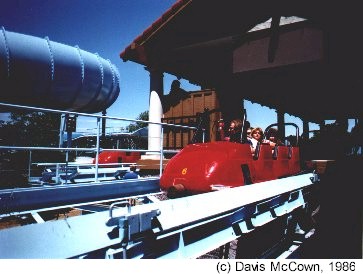
For the celebration of Six Flags Over Texas’ 25th Anniversary, the Avalanche Bobsled Ride was introduced. Located in the area of the park that had formally held the Fiesta train, the Bobslide’s new feature was that it did not ride on a track. Instead, the cars rode in a curve structure, more similar to the log ride’s flume or chute than a roller coaster track. The result of this configuration was that not every ride was exactly the same as the one before it.

It also created the illusion that the cars could leave the flume area, creating an apprehension of danger. With a lift height of sixty feet, and a track length of 1,490 feet, the ride travels at up to 32 MPH for a ride of approximately 1 and one half minutes to ride.
While the ride was new to Six Flags over Texas, it was not new to the Six Flags’ park system, having operated at Magic Mountain from 1984 to 1987. Built by Intamin, the ride is an AG Bobsled style ride.

Originally painted blue, the structure was repainted in red and yellow sections to resemble the strips of a snake. It was renamed the La Vibora, Spanish for the “Viper”, brining it more closely into the theming of the Mexican section where it resides. Counting the AR as a roller coaster increased Six Flags Roller Coaster to five, the highest it had been to date. The ride was moved from Six flags Magic Mountain where it was installed in 1984.
